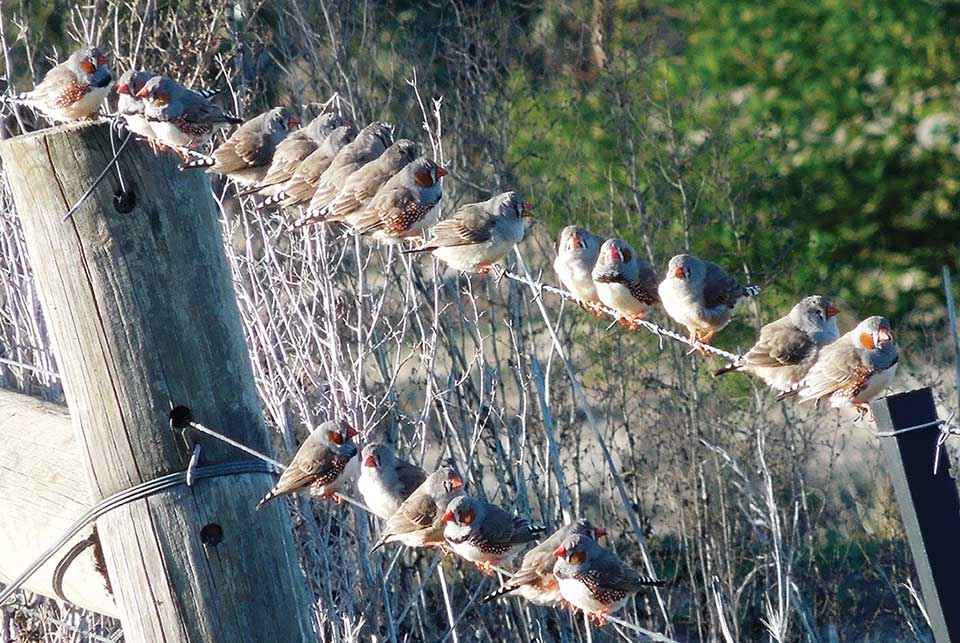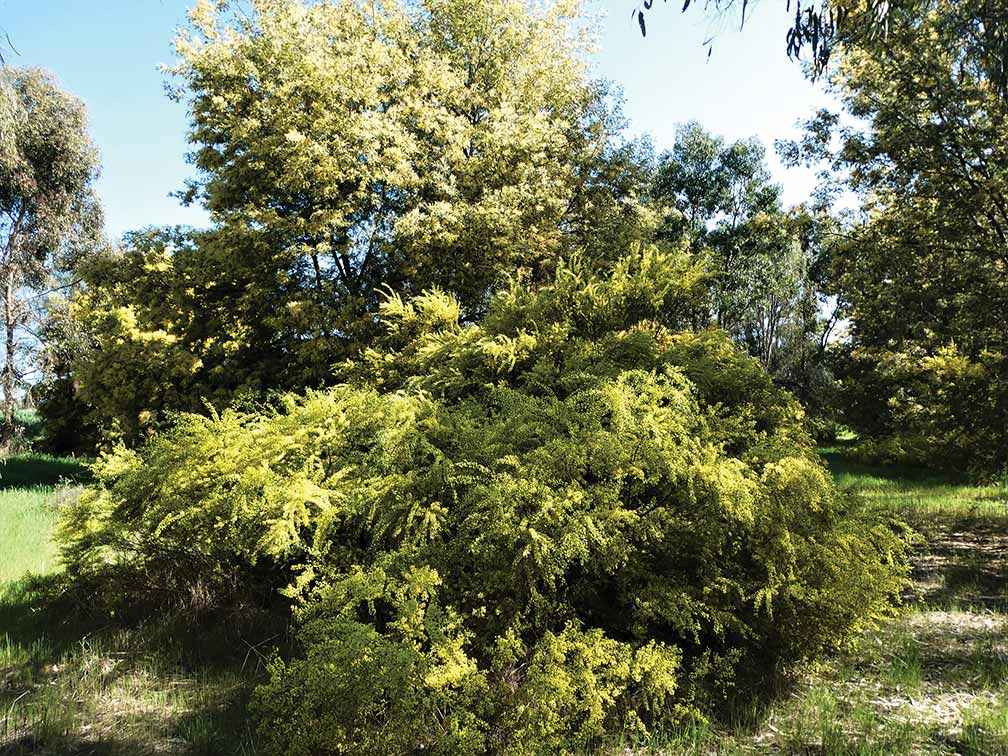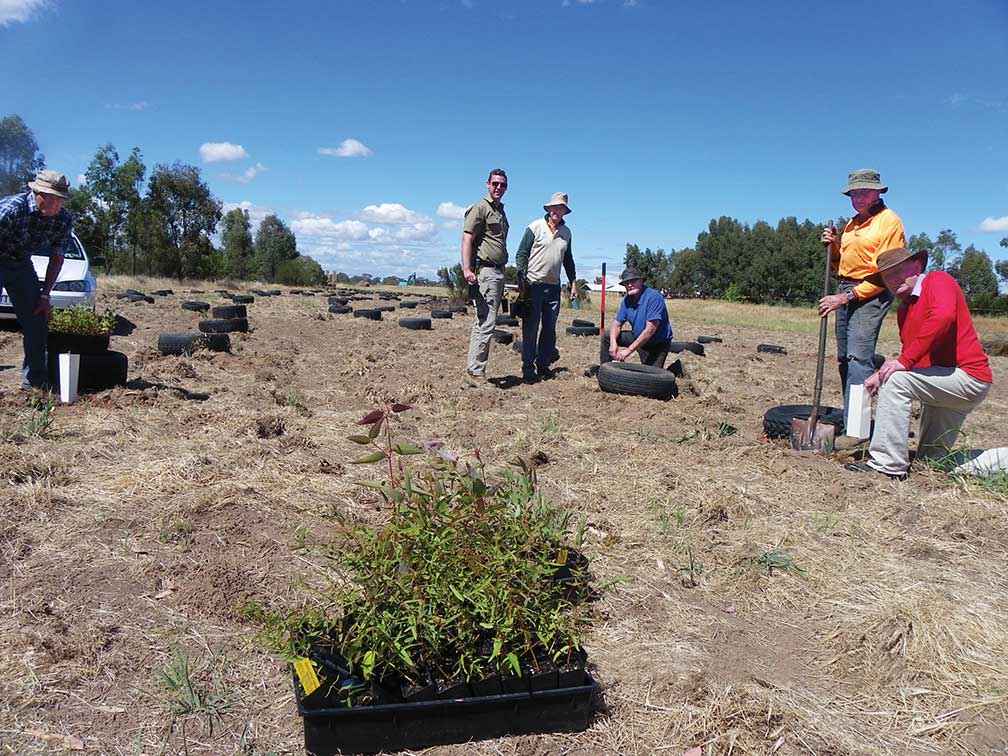Victorian Landcare Magazine - Spring 2024, Issue 88

In 2001 the Shire of Campaspe handed the management of Kyabram town’s South Boundary Road Drainage Basin to the Kyabram Urban Landcare Group (KULG). It is now the Ern Miles Reserve, named after one of KULG’s hardworking and visionary members
Kyabram is an Aboriginal word meaning thick forest, but there was little evidence of that when the project began. The reserve was former farmland that was used for cropping and cattle grazing. The only remnant vegetation on the entire 28-hectare site was eight mature and two dead grey box trees (Eucalyptus microcarpa). Our vision was to revegetate the degraded, weed-infested site back to native bushland, creating habitat to support diminishing wildlife and areas for the public to enjoy.
KULG began the huge revegetation task in 2002 by deep ripping the areas to be planted. Grade five and six students from Haslem Street Primary School (who are now at Kyabram P-12 College) planted over 200 tubestock with indigenous species of eucalypts, acacias, sennas and dodoneas under the existing grey box to begin the growth of understorey.

Above: Native vegetation in the Ern Miles Reserve in 2021, which was established through direct seeding in 2011.
Since that first planting, students from Dawes Road Primary School, St. Augustine’s College and Kyabram P-12 College were involved in further revegetation projects at the site, right up to 2018.
We also enjoyed working with planting teams from Dhurringile Prison, Goulburn Murray Landcare Network (GMLN), Kyabram Girl Guides and Boy Scouts, Rural Finance employees, and an unemployed Kyabram youth team. KULG members and other community volunteers worked alongside these groups planning, advising, supervising, and catering for the planting events.
We deep ripped sites a few days before planting and achieved a good survival rate of tubestock. Almost 100 per cent survived a very wet planting in 2010. In drier conditions watering the seedlings was critical. Following a winter or a spring plant, regular watering of the plants continued right through to the beginning of the following autumn, but especially through summer.
Two direct seeding events undertaken by a contractor who used local provenance seed from Goulburn Broken Indigenous Seedbank at Dookie were successful. We didn’t rip the soil beforehand, but even with a very dry year in 2006 (it was the height of the millennium drought) we still had a good strike of seedlings. The direct seeding event in 2011 followed some wet months. A dense covering of hogweed and other weeds were burnt off before and an excellent strike of endemic shrubs resulted – mainly wattle species and hopbush (Dodonea viscosa).
The project has received funding from Campaspe Shire, a 2019 Victorian Landcare Grant, along with contributions from Goulburn Broken CMA, GMLN, and Kyabram Fauna Park.

Above: Kyabram Urban Landcare group and Kyabram Fauna Park members planting eucalypts for koalas in 2018.
Flood, drought, frost and weeds have created challenges and sometimes failures. Watering young plants, especially during the drought, proved difficult. The work was constant and put a huge load on our members, who are mostly well into retirement.
One planting took place on the morning of a heavy mid-winter frost. For time efficiency purposes we placed the tubestock out in position the evening before. All the seedlings died. Flood events in 2010/11 and in 2022 killed young plants so some areas required replanting. When plants died before they set seed it meant there was no regeneration.
Removing weeds such as caltrop, Paterson’s curse, Bathurst burr and other thistles were a continual issue. Rabbits, foxes and hares also caused some damage and required control.
The beauty of the flowering wattles in late winter and early spring is something to behold.
The success of our project can be seen in the delight of the many locals who now visit the reserve. The beauty of the flowering wattles in late winter and early spring is something to behold. There are twelve endemic species present in the reserve including Australia’s floral emblem, golden wattle (Acacia pycnantha), as well as silver wattle (A. dealbata), hakea wattle (A. hakeoides) and gold-dust wattle (A. acinacea.)
Native wildlife has returned, with kangaroos and the occasional wallaby gracing the reserve. Kyabram Fauna Park funded the planting of 300-koala food eucalypts in 2018. River red gum (Eucalyptus camaldulensis), manna gum (E. viminalis) and yellow box (E. melliodora) are now well established.
Despite the hard work and the many challenges, the project has been a resounding success.
Birdlife is a real highlight. We have kept a record of birds at the reserve since 2001 when we recorded 36 species as regular visitors. This has now increased to a total of 132 different species sighted. Undoubtedly the revegetation was responsible for the return of at least 40 bird species. Painted buttonquail, rufous and golden whistler, superb fairy wren, grey fantail and several thornbill species would never be observed if it weren’t for our revegetation project.
Despite the hard work and the many challenges, the project has been a resounding success. We established thousands of indigenous plants in our reserve, improving the biodiversity of our environment. The sense of community the project has created is of enormous value.
Neville Hunter is Secretary of the KULG.
For more information email dan@gmln.com.au